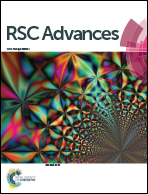A novel self-seeding polyol synthesis of Ag nanowires using mPEG-b-PVP diblock copolymer†
Abstract
The homopolymer of poly(N-vinylpyrrolidone) (PVP) is typically chosen as a capping agent for the polyol synthesis of silver nanowires (Ag NWs). In this paper, we first introduced methoxy poly(ethylene glycol)-b-PVP diblock copolymer (mPEG-b-PVP), which was synthesized by reversible addition–fragmentation transfer (RAFT) polymerization, as a capping agent instead of the PVP homopolymer to the polyol process. Ag NWs were successfully synthesized by this self-seeding process without the addition of any other additives, such as metal salt or exotic seed. The Ag NWs were analyzed by field emission-scanning electron microscopy (FE-SEM), transmission electron microscopy (TEM), X-ray diffraction (XRD) and Fourier transform-infrared spectroscopy (FT-IR). In addition, the relationship between the final morphology of the products and the reaction parameters, such as the molar ratio of mPEG-b-PVP to AgNO3, injection rate, and temperature, were studied. Finally, under the optimum conditions, the Ag NWs, which were nearly uniform in size, measured 60 to 75 nm in diameter and were as long as ∼20 μm. Notably, the synthesized Ag NWs can be dispersed in a non-polar solvent due to the surface PEG tails. This improvement in the dispersion stability may broaden the application of Ag NWs.


 Please wait while we load your content...
Please wait while we load your content...